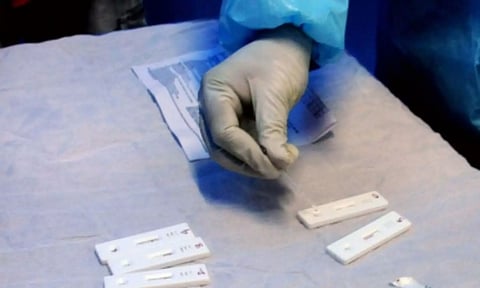

NEW YORK: US researchers have developed a new and rapid test that can detect both HIV and tuberculosis (TB) at the same time with just a small amount of blood.
The new blood-based test, described in a new paper published in the journal Clinical Chemistry, can not only detect the two diseases but also measure their viral and bacterial loads in patients.
HIV and TB are common coinfections, meaning they often occur together. One of the symptoms of HIV is a suppressed immune system, which makes patients more likely to contract infections like TB. In fact, the HIV-infected population is at the highest risk of contracting TB.
“For HIV patients, their immune system is very weak, and once they are infected, they can’t confront the bacteria very well, so that’s why there is this urgent need to bring blood-based TB tests to them,” said Tony Hu, director of the Center for Cellular and Molecular Diagnostics at Tulane University’s School of Medicine.
“For the TB-infected patients, they worry, ‘Why did I get TB? Is it because I have HIV?’ So, this is a multiplex detection to cover both pathogens,” he added.
Typically, TB tests are done by bacterial culture of sputum, which takes a long time and can be impractical when patients are in urgent need of treatment.
Sputum, a mixture of saliva and mucus, is also a product of immune response and thus not an option for patients who have HIV, because of their suppressed immune systems.
This blood-based test avoids the need for sputum and allows patients with HIV to be tested for TB. It also only requires 200 microliters of blood, which is only a few drops.
By combining these tests, “you can save costs and save time,” Hu said.
The test targets HIV and TB antigens in the blood and uses mass spectrometry to detect the viral and bacterial loads.
One of the important aspects of this test is that it allows doctors to track the levels of both HIV and TB in a patient as they undergo treatment, meaning they can intervene quickly if a certain treatment isn’t working.
“You cannot treat them simultaneously. You have to pick one to treat first: HIV or TB,” Hu said. “If you treat HIV first, you may boost the TB bacterial load.”
This condition, where treating one disease causes a resurgence in the other, is called immune reconstitution inflammatory syndrome, or IRIS. The speed of this test means that doctors can catch this earlier and change a patient’s treatment plan for better patient outcomes.
The new test could be significant for developing countries where TB affects more people and where it can be difficult to get tests to the people who need them.
Hu hopes that this pilot study will be able to move to clinical trials soon to get the tests US FDA approved.